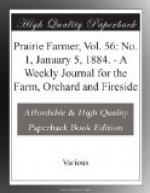It is announced that Robert Clarke, of Cincinnati will have ready, in February, an extensive work on sorghum, containing the results of the latest experiments and experience of the most successful growers, as to the best varieties and their culture, and also the details of the latest and best machinery used in the economical manufacture of sirups and sugars therefrom. The work is by Prof. Peter Collier, whose name is a guarantee of the value of the book. It will be very fully illustrated.
A Michigan man writes the Michigan Farmer: I have noticed tarred twine and willows recommended for binding corn stalks. I think I can propose a better substitute than either for those who are using a twine binder: save the strings from straw stacks this winter. They are less trouble than grass and never slip. Tie a knot in the end of the twine with your knee on the bundle, then slip the other end through in the form of a bow, take off your knee and the spring of the bundle will draw the knot tight. Pull the bow and use again.
“Human labor,” says Dr. Zellner, of Ashville, Ala., “is the most costly factor that enters into the production of cotton, and every consistent means should be adopted to dispense with it.” And then the doctor, who has the reputation of having raised some of the finest samples ever grown in the South, describes how, by planting at proper distances, in checks five by three apart, one-half of the after labor of cultivating may be saved. About the same amount of plow work is said to be necessary, but not more than one-fourth as much work with the hoe as is required by cotton in drills.
Prof. J.W. Sanborn: “Deep tillage in times of drought of surface-rooted crops, like corn, is an erroneous practice, founded on erroneous views. ‘Plowing out corn’ not only involves too deep tillage in drought but adds to the mischief by severing the roots of corn, needed at such times. Our double-shovel plows work too deeply. Our true policy, in drought, for corn is frequent and shallow tillage. For this we now have after the corn gets beyond the smoothing harrow, no suitable implement on our markets, with a possible exception.”
Correspondent New York Tribune: Of the use of oatmeal for cows mention is not often made in this country; but when spoken of it is always with praise. That it is better than corn meal there can be no doubt; it is richer in both albuminoids and fat; and the usefulness of these two nutriments, and especially the former, for making milk is shown not only by the results of numerous careful experiments, but by the acknowledged usefulness of oil-cake meal. Where this meal is used freely there would be less use for oatmeal; but under some circumstances it might be advantageously substituted for the bran in the favorite mixture for cows of Indian meal and bran.




